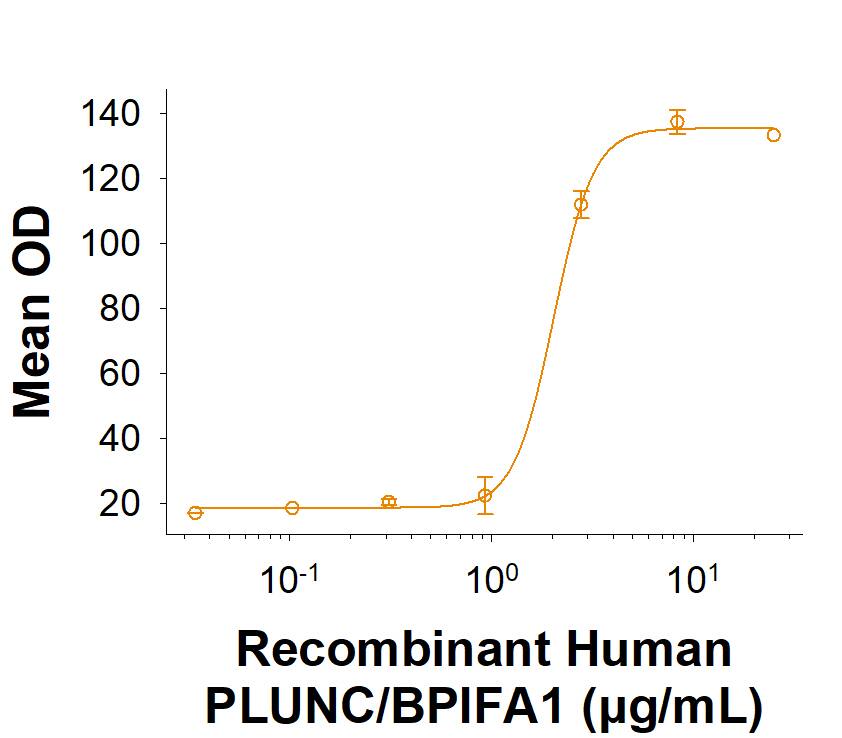Recombinant Human PLUNC BPIFA1 His-tag Protein, CF
R&D Systems, part of Bio-Techne | Catalog # 11221-BF

Key Product Details
Product Specifications
Source
Human embryonic kidney cell, HEK293-derived human PLUNC protein
Gln20-Val256, with a C-terminal 6-His tag
Gln20-Val256, with a C-terminal 6-His tag
Purity
>95%, by SDS-PAGE visualized with Silver Staining and quantitative densitometry by Coomassie® Blue Staining.
Endotoxin Level
<0.10 EU per 1 μg of the protein by the LAL method.
N-terminal Sequence Analysis
Gln20; deblocked shows Phe21
Predicted Molecular Mass
25 kDa
SDS-PAGE
21-28 kDa, under reducing conditions.
Activity
Measured by its ability to bind fluorescein conjugated E.
coli bio-particles. The ED50 for this effect is 0.500-5.00 μg/mL.
Scientific Data Images for Recombinant Human PLUNC BPIFA1 His-tag Protein, CF
Recombinant Human PLUNC BPIFA1 His-tag Protein Binding Activity.
Measured by its ability to bind fluorescein conjugated E. coli bio-particles. The ED50 for this effect is 0.500-5.00 μg/mL.Recombinant Human PLUNC BPIFA1 His-tag Protein SDS-PAGE.
2 μg/lane of Recombinant Human PLUNC BPIFA1 His-tag Protein (Catalog # 11221-BF) was resolved with SDS-PAGE under reducing (R) and non-reducing (NR) conditions and visualized by Coomassie® Blue staining, showing bands at 21-28 kDa.Formulation, Preparation and Storage
11221-BF
| Formulation | Lyophilized from a 0.2 μm filtered solution in PBS with Trehalose. |
| Reconstitution | Reconstitute at 250 μg/mL in PBS. |
| Shipping | The product is shipped at ambient temperature. Upon receipt, store it immediately at the temperature recommended below. |
| Stability & Storage | Use a manual defrost freezer and avoid repeated freeze-thaw cycles.
|
Background: PLUNC
References
- Bingle, C.D. and C. J. Craven (2002) Hum. Mol. Genet. 11:937.
- Alves, D.B. et al. (2017) Braz. Oral Res. 31:e6.
- Bingle, L. et al. (2012) Histochem. Cell Biol. 138:749.
- De Smet, E.G. et al. (2017) Int. J. Chron. Obstruct. Pulmon. Dis. 13:11.
- Saferali, A. et al. (2015) Am. J. Respir. Cell. Mol. Biol. 53:607.
Long Name
Palate, Lung, and Nasal Epithelium Associated
Alternate Names
BPIFA1, LUNX, SPLUNC1
Entrez Gene IDs
51297 (Human)
Gene Symbol
BPIFA1
UniProt
Additional PLUNC Products
Product Documents for Recombinant Human PLUNC BPIFA1 His-tag Protein, CF
Product Specific Notices for Recombinant Human PLUNC BPIFA1 His-tag Protein, CF
For research use only
